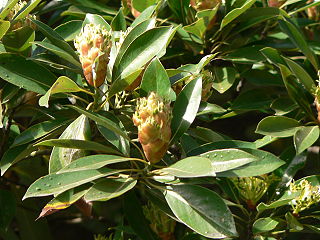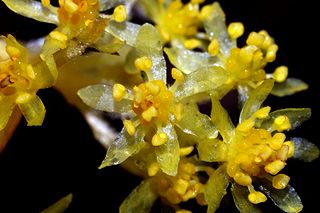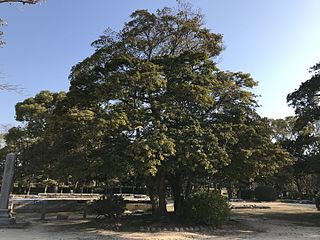
An oak is a hardwood tree or shrub in the genus Quercus of the beech family. They have spirally arranged leaves, often with lobed edges, and a nut called an acorn, borne within a cup. The genus is widely distributed in the Northern Hemisphere; it includes some 500 species, both deciduous and evergreen. Fossil oaks date back to the Middle Eocene. Molecular phylogeny shows that the genus is divided into Old World and New World clades, but many oak species hybridise freely, making the genus's history difficult to resolve.

Lauraceae, or the laurels, is a plant family that includes the true laurel and its closest relatives. This family comprises about 2850 known species in about 45 genera worldwide. They are dicotyledons, and occur mainly in warm temperate and tropical regions, especially Southeast Asia and South America. Many are aromatic evergreen trees or shrubs, but some, such as Sassafras, are deciduous, or include both deciduous and evergreen trees and shrubs, especially in tropical and temperate climates. The genus Cassytha is unique in the Lauraceae in that its members are parasitic vines. Most laurels are highly poisonous.

Persea is a genus of about 150 species of evergreen trees belonging to the laurel family, Lauraceae. The best-known member of the genus is the avocado, P. americana, widely cultivated in subtropical regions for its large, edible fruit.

Casuarina, also known as she-oak, Australian pine and native pine, is a genus of flowering plants in the family Casuarinaceae, and is native to Australia, the Indian subcontinent, Southeast Asia, islands of the western Pacific Ocean, and eastern Africa.

Cinnamomum tamala, Indian bay leaf, also known as tejpat, tejapatta,Malabar leaf, Indian bark, Indian cassia, or malabathrum, is a tree in the family Lauraceae that is native to India, Bangladesh, Nepal, Bhutan, and China. It can grow up to 20 m (66 ft) tall. Its leaves have a clove-like aroma with a hint of peppery taste; they are used for culinary and medicinal purposes. It is thought to have been one of the major sources of the medicinal plant leaves known in classic and medieval times as malabathrum.

Ambrosia artemisiifolia, with the common names common ragweed, annual ragweed, and low ragweed, is a species of the genus Ambrosia native to regions of the Americas.

Machilus is a genus of flowering plants in the family Lauraceae. It is found in temperate, subtropical, and tropical forest, occurring in China, Korea, Japan, Taiwan, Indochina, the Indian subcontinent, Malaysia, Indonesia, and the Philippines. It is sometimes included in the genus Persea, and currently includes about 100 species.

The black wood pigeon or Japanese wood pigeon is a species of bird in the family Columbidae. It is found in East Asia along shorelines of the Pacific's Korea Strait, Philippine Sea and East China Sea. It is believed to be the largest representative of the genus, Columba, and has a weight of around 550 grams (1.2 lb) and an overall length of 43 cm (17 in). Its natural habitats are temperate forests and subtropical or tropical moist lowland forests. The species is in decline owing to habitat loss, habitat degradation, deforestation and hunting. This wood pigeon is endemic to the laurel forest habitat.

Sassafras randaiense is a species of deciduous tree in the family Lauraceae belonging to the genus Sassafras. It is a relict species endemic to Taiwan. It is threatened by habitat loss.
Orseolia oryzae, also called the Asian rice gall midge, is a species of small fly in the family Cecidomyiidae. It is a major insect pest of rice. The damage to the crop is done by the larvae which form galls commonly known as "silver shoots" or "onion shoots". The rice plant is stunted and the seed heads fail to develop.
Daphnephila truncicola is a species of gall midges first associated with stem galls on Lauraceae species, particularly Machilus thunbergii in Taiwan. Based on analysis on sequences of the mitochondrial cytochrome c oxidase subunit I, it has been suggested that in this genus, the stem-galling habit is a more ancestral state as opposed to the leaf-galling habit. This genus appears to have originated tropically and dispersed to Japan through Taiwan.
Daphnephila taiwanensis is a species of gall midges first associated with leaf galls on Lauraceae species, particularly Machilus thunbergii in Taiwan. Based on analysis on sequences of the mitochondrial cytochrome c oxidase subunit I, it has been suggested that in this genus, the stem-galling habit is a more ancestral state as opposed to the leaf-galling habit. This genus appears to have originated tropically and dispersed to Japan through Taiwan.
Daphnephila ornithocephala is a species of gall midge first associated with leaf galls on Lauraceae species, particularly Machilus thunbergii in Taiwan. Based on analysis on sequences of the mitochondrial cytochrome c oxidase subunit I, it has been suggested that in this genus, the stem-galling habit is a more ancestral state as opposed to the leaf-galling habit. This genus appears to have originated tropically and dispersed to Japan through Taiwan.
Daphnephila stenocalia is a species of gall midges first associated with leaf galls on Lauraceae species, particularly Machilus thunbergii in Taiwan. Based on analysis on sequences of the mitochondrial cytochrome c oxidase subunit I, it has been suggested that in this genus, the stem-galling habit is a more ancestral state as opposed to the leaf-galling habit. This genus appears to have originated tropically and dispersed to Japan through Taiwan.

Asphondyliini is a tribe of gall midges in the family Cecidomyiidae. There are about six genera and at least 100 described species in Asphondyliini.
This article records new taxa of fossil plants that are scheduled to be described during the year 2019, as well as other significant discoveries and events related to paleobotany that are scheduled to occur in the year 2019.
Daphnephila is a genus of gall midge that appears in the Palearctic and Oriental biogeographic realms. Daphnephila species create leaf and stem galls on species of laurel plants, particularly in Machilus. Based on analysis on sequences of the mitochondrial cytochrome c oxidase subunit I, it has been suggested that in this genus, the stem-galling habit is a more ancestral state as opposed to the leaf-galling habit.

Anantanarayanan Raman is a Professor of Ecology with Charles Sturt University, NSW and a scientist with CSIRO, Australia.

Machilus thunbergii, the Japanese bay tree, red machilus, or tabunoki, is a widespread species of flowering plant in the family Lauraceae. It is native to Vietnam, Taiwan, southeast and north-central China, the Korean Peninsula, and Japan. A sturdy evergreen tree, usually 10–15 m (30–50 ft) tall, and reaching 20 m (70 ft), it is used for timber, and as a street tree. Its bark is the source of makko, a powder used to make a mosquito‑repelling incense. It prefers coastal areas, and can handle saline soil.
This paleobotany list records new fossil plant taxa that were to be described during the year 2022, as well as notes other significant paleobotany discoveries and events which occurred during 2022.











